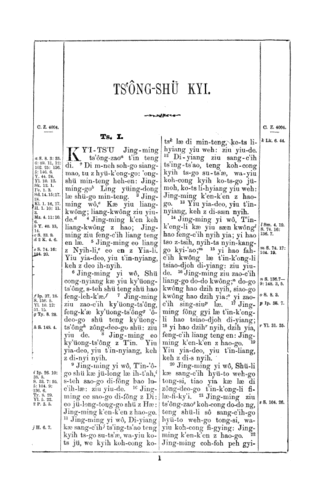Top Qs
Timeline
Chat
Perspective
Ningbo dialect
Dialect of Wu Chinese From Wikipedia, the free encyclopedia
Remove ads
The Ningbo dialect (Chinese: 宁波话/寧波話, 宁波闲话/寧波閒話) is a dialect of Wu Chinese, one subdivision of Chinese language. Ningbo dialect is spoken throughout Ningbo and Zhoushan prefectures, in Zhejiang province.

Remove ads
Intelligibility
Ningbo dialect native speakers generally understand Shanghainese, another dialect of Wu. However, Shanghainese speakers do not always have full understanding of the Ningbo dialect. It is not mutually intelligible with Mandarin Chinese, or any other subdivision of the Chinese languages. The Ningbo dialect is considered a Yongjiang dialect or Mingzhou dialect (as both terms are synonymous), and is closely related to the Taihu Wu dialects of Zhoushan. In terms of inter-intelligibility between dialects within the Yong-Jiang subgroup, they can be more accurately described as 'accents' (腔) as these dialects are relatively uniform and almost identical to each other aside from pronunciation differences and some minor lexical differences.
Remove ads
Phonology
Summarize
Perspective
Initials
Finals
- Syllabic continuants: [z̩] [z̩ʷ] [m̩] [n̩] [ŋ̩] [l̩]
Notes:
- The table contains two additional finals /yɲ, ɥøʔ/. These have merged with /joŋ, joʔ/ respectively in younger generations.
- /y, ʏ/ are similar in pronunciation, differing slightly in lip rounding ([y, iᵝ] respectively). The two are merged in younger generations.
- /j/ is pronounced [ɥ] before rounded vowels.
The Middle Chinese [-ŋ] rimes are retained, while [-n] and [-m] are either retained or have disappeared in the Ningbo dialect. Middle Chinese [-p -t -k] rimes have become glottal stops, [-ʔ].
Tones
Remove ads
Examples
唱月亮
- 月亮菩薩彎彎上,彎到小姑進后堂。
- 后堂空,拜相公,
- 相公念經,打一天井,
- 天井隔笆,打一稻花,
- 稻花耘田,打一團箕。
火瑩頭
- 火瑩頭,夜夜紅,
- 阿公挑擔賣碗蔥,
- 新婦織麻糊燈籠,
- 阿婆箝牌捉牙虫,
- 兒子看鴨撩屙虫。
See also
References
Wikiwand - on
Seamless Wikipedia browsing. On steroids.
Remove ads
